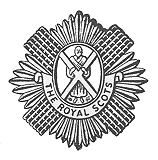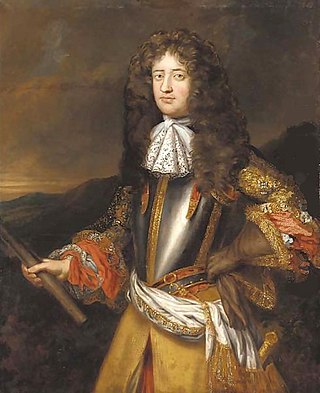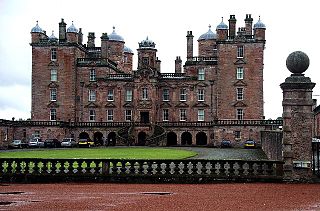Related Research Articles

The Royal Scots, once known as the Royal Regiment of Foot, was the oldest and most senior infantry regiment of the line of the British Army, having been raised in 1633 during the reign of Charles I. The regiment existed continuously until 2006, when it amalgamated with the King's Own Scottish Borderers to become the Royal Scots Borderers, which merged with the Royal Highland Fusiliers, the Black Watch, the Highlanders and the Argyll and Sutherland Highlanders to form the Royal Regiment of Scotland.

The Royal Warwickshire Regiment, previously titled the 6th Regiment of Foot, was a line infantry regiment of the British Army in continuous existence for 283 years. The regiment saw service in many conflicts and wars, including the Second Boer War and both the First and Second World Wars. On 1 May 1963, the regiment was re-titled, for the final time, as the Royal Warwickshire Fusiliers and became part of the Fusilier Brigade.

Major-General George Douglas, 1st Earl of Dumbarton KT was a Scottish military officer who spent much of his career in the service of King Louis XIV. In 1678, he returned to England; as a Catholic, he was a trusted servant of King James II and went into exile with him after the 1688 Glorious Revolution. He died at the palace of St Germain-en-Laye in March, 1692.

The Royal Irish Regiment, until 1881 the 18th Regiment of Foot, was an infantry regiment of the line in the British Army, first raised in 1684. Also known as the 18th Regiment of Foot and the 18th Regiment of Foot, it was one of eight Irish regiments raised largely in Ireland, its home depot in Clonmel. It saw service for two and a half centuries before being disbanded with the Partition of Ireland following establishment of the independent Irish Free State in 1922 when the five regiments that had their traditional recruiting grounds in the counties of the new state were disbanded.

The Scots Guards (SG) is one of the five Foot Guards regiments of the British Army. Its origins are as the personal bodyguard of King Charles I of England and Scotland. Its lineage can be traced back to 1642 in the Kingdom of Scotland, although it was only placed on the English Establishment in 1686.

The King's Own Royal Regiment (Lancaster) was a line infantry regiment of the British Army. It served under various titles and fought in many wars and conflicts, including both the First and the Second World Wars, from 1680 to 1959. In 1959, the regiment was amalgamated with the Border Regiment to form the King's Own Royal Border Regiment.
Charles Schomberg, 2nd Duke of Schomberg was a general in the Prussian, Dutch and British Army, the second in the Von Schonberg line to be Duke of Schomberg, a title in the Peerage of England. His father was Frederick, the first Duke.

The 5th Dragoon Guards was a British army cavalry regiment, officially formed in January 1686 as Shrewsbury's Regiment of Horse. Following a number of name changes, it became the 5th Regiment of Dragoon Guards in 1804.

General Sir Charles Wills was a British Army officer and politician who served as Lieutenant-General of the Ordnance sat as a member of parliament for Totnes from 1718 to 1741.

William Stewart, 1st Viscount Mountjoy (1653–1692), was an Anglo-Irish soldier.
Sir Thomas Smyth, 2nd Baronet was a soldier of the British Army.
General Gervais Parker was a British Army officer. For the final decade of his life, he served as Commander-in-Chief of the Royal Irish Army during the reign of George II.

Lieutenant-General George Ramsay was a younger son of the Earl of Dalhousie and Scottish professional soldier.

Lieutenant-General James Douglas (1645–1691), younger brother of the Duke of Queensberry, was a Scottish military officer, who served as MP for Peeblesshire in the 1685 to 1686 Parliament of Scotland.

Major General Francis Fergus O’Farrellc. 1650 to 1712, was an Irish-born professional soldier who served in the Dutch States Army under William III until 1689, when he transferred into the English Army. During the Nine Years' War in 1695, he was cashiered for his premature surrender of the town of Deinze, then reinstated in 1696 and served in the War of the Spanish Succession.
Major-General Thomas Handasyd was a British Army officer and colonial administrator who served as the governor of Jamaica from 1702 until 1711. Born in Elsdon, Northumberland, he served during the Stuart period from 1674 to 1710.
Sir James Leslie or Lesley was a British army officer of the seventeenth century.
Lieutenant-General Charles Sybourg was a British Army officer.
Sir Charles Hotham, 4th Baronet, of Scorborough and later of Beverley and South Dalton, was a British Army officer and Whig politician who sat in the English House of Commons and British House of Commons from 1695 to 1723.

Philip Babington (1632–1690) was an English military officer, who served in the armies of the Commonwealth of England, the Dutch Republic and England. He accompanied William III to England in the 1688 Glorious Revolution and was Member of Parliament and Governor for Berwick-upon-Tweed from 1689 to 1690.
References
- 1 2 3 G. E. C., The Complete Baronetage, volume II (1902) p. 284.
- ↑ Charles Dalton, English Army Lists and Commission Registers 1661–1714, volume I (1892) p. 318.
- ↑ Dalton, English Army Lists, vol. I, p. 330.
- ↑ Dalton, English Army Lists, volume II (1894) p. 22.
- ↑ Dalton, English Army Lists, vol. II, p. 182.
- ↑ Dalton, English Army Lists, vol. II, p. 131.
- ↑ Dalton, English Army Lists, volume III (1896) p. 47.
- ↑ Dalton, English Army Lists, vol. III, p. 139.
- ↑ Richard Cannon, Historical Record of the First, or Royal Regiment of Foot (1847) p. 80.
- ↑ Dalton, English Army Lists, vol. III, p. 192.
- ↑ Cannon, p. 81.
- ↑ Cannon, pp. 81-83.